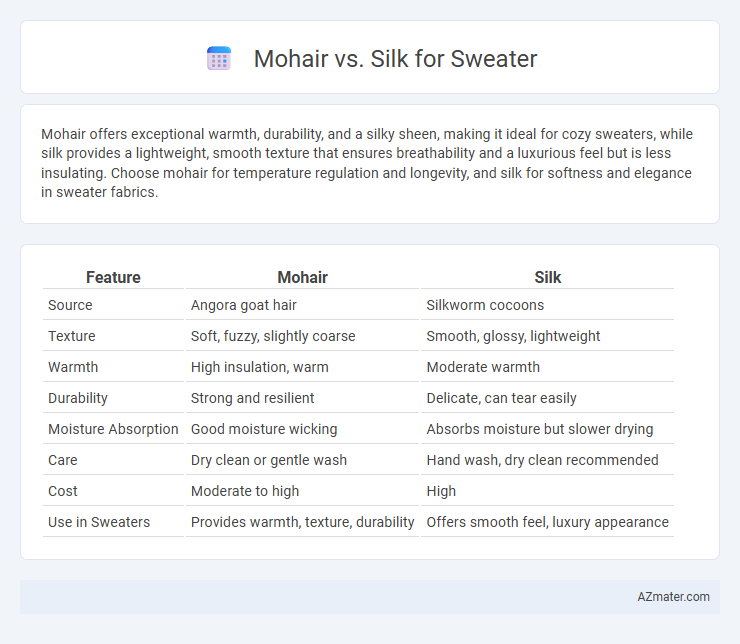Mohair offers exceptional warmth, durability, and a silky sheen, making it ideal for cozy sweaters, while silk provides a lightweight, smooth texture that ensures breathability and a luxurious feel but is less insulating. Choose mohair for temperature regulation and longevity, and silk for softness and elegance in sweater fabrics.
Table of Comparison
| Feature | Mohair | Silk |
|---|---|---|
| Source | Angora goat hair | Silkworm cocoons |
| Texture | Soft, fuzzy, slightly coarse | Smooth, glossy, lightweight |
| Warmth | High insulation, warm | Moderate warmth |
| Durability | Strong and resilient | Delicate, can tear easily |
| Moisture Absorption | Good moisture wicking | Absorbs moisture but slower drying |
| Care | Dry clean or gentle wash | Hand wash, dry clean recommended |
| Cost | Moderate to high | High |
| Use in Sweaters | Provides warmth, texture, durability | Offers smooth feel, luxury appearance |
Introduction: Mohair vs Silk for Sweaters
Mohair fibers, derived from the Angora goat, offer lightweight insulation and natural sheen perfect for cozy sweaters, while silk provides a smooth, breathable texture with excellent moisture-wicking qualities. Mohair sweaters are prized for their durability and warmth, making them ideal for colder climates, whereas silk sweaters excel in softness and elegance, suitable for layering in milder temperatures. Choosing between mohair and silk involves balancing warmth, texture, and the intended wear environment for optimal comfort and style.
Origins and Production Processes
Mohair originates from the Angora goat, primarily farmed in South Africa and Turkey, where fibers are sheared twice annually to ensure long, silky strands. Silk is produced by the mulberry silkworm in countries like China and India, with fibers extracted through a delicate reeling process after the larvae spin cocoons. The distinct production methods of mohair and silk significantly influence the texture, durability, and thermal properties of sweaters made from these materials.
Texture and Feel on the Skin
Mohair sweaters offer a luxurious, fluffy texture known for its softness and slight halo effect that provides warmth without weight, making it gentle and cozy against the skin. Silk sweaters deliver a smooth, sleek feel characterized by natural sheen and breathability, ensuring a cool, comfortable touch ideal for sensitive skin or warmer climates. While mohair emphasizes plush insulation and a slightly fuzzy surface, silk prioritizes smoothness and moisture-wicking properties for a silky finish on the skin.
Warmth and Insulation Properties
Mohair offers superior warmth and insulation due to its long, hollow fibers that trap air effectively, making it ideal for sweaters in cold climates. Silk, while lightweight and smooth, provides moderate insulation but excels in moisture-wicking and breathability rather than heat retention. Choosing mohair ensures enhanced thermal regulation and cozy comfort, whereas silk is better suited for layering or milder temperatures.
Breathability and Moisture Management
Mohair offers excellent breathability due to its natural hollow fibers, allowing air circulation and effective moisture wicking, which keeps the wearer dry and comfortable. Silk provides moderate breathability and absorbs moisture well but tends to retain dampness longer, making it less efficient in moisture management compared to mohair. For sweaters, mohair's superior ventilation and rapid moisture evaporation make it ideal for maintaining comfort during varying temperatures.
Durability and Longevity
Mohair offers superior durability and longevity compared to silk, as its natural protein fibers resist abrasion and pilling, making it ideal for long-lasting sweaters. Silk, while luxurious and soft, tends to be more delicate and prone to damage from friction and washing, which can shorten the lifespan of silk sweaters. Mohair's resilience to wear and ability to maintain shape over time ensures sweaters retain their quality through multiple seasons.
Care and Maintenance Requirements
Mohair sweaters require delicate care, including gentle hand washing or dry cleaning to maintain their softness and prevent fiber damage, while silk sweaters demand even more meticulous handling, often necessitating cold water hand washing and avoiding exposure to sunlight to preserve their luster. Both fabrics benefit from storage in breathable garment bags to prevent moth damage and moisture buildup. Proper care extends the lifespan of mohair and silk sweaters, maintaining their luxurious texture and appearance.
Eco-Friendliness and Sustainability
Mohair is derived from the Angora goat, promoting sustainable farming practices through its renewable fiber, which requires less water and fewer chemicals compared to silk production that relies on silkworm cultivation and mulberry trees. Silk manufacturing often involves higher energy consumption and chemical use, posing environmental challenges, whereas mohair fibers biodegrade quickly and support biodiversity by maintaining grazing lands. Choosing mohair sweaters enhances eco-friendliness through animal welfare considerations and reduced resource extraction, making it a more sustainable textile option than conventional silk.
Price Comparison and Value
Mohair sweaters generally cost less than silk sweaters due to the lower price of mohair fiber sourced from Angora goats compared to the delicate silk produced by silkworms. Mohair offers excellent durability and warmth at a more budget-friendly price point, making it a valuable choice for cost-conscious consumers. Silk sweaters command a premium price reflecting their luxurious feel, natural sheen, and lightweight softness, offering superior breathability and elegance that justify the higher investment.
Best Uses and Style Recommendations
Mohair sweaters excel in warmth and durability, making them ideal for cold weather and layering in casual or cozy outfits. Silk sweaters offer a lightweight, smooth texture perfect for elegant, breathable attire suitable for mild climates or formal occasions. Both fabrics complement different style needs: mohair pairs well with rugged, textured looks while silk enhances sleek, polished ensembles.

Infographic: Mohair vs Silk for Sweater
 azmater.com
azmater.com